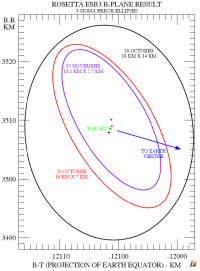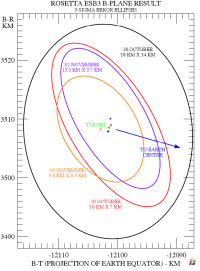No. 123 - Earth swingby preparations
All the commands required for the swingby activities are now on-board.
Mission operations have been conducted with support of the ESA New Norcia (NNO) ground station. In addition several tracking passes with the NASA DSN ground stations Goldstone (DSS-24) and Madrid (DSS-54) were taken in support of the Earth swingby navigation campaign.
| DOY | Date | Pass | Main Activity |
| 304 | 31/10/09 | DSS-24 2074 |
Monitoring pass |
| 305 | 01/11/09 | NNO 2074 DSS-54 2075 |
Uplink of Earth swingby commands |
| 306 | 02/11/09 | DSS-54 2076 |
Monitoring pass |
| 307 | 03/11/09 |
NNO 2077 |
Monitoring pass |
| 308 | 04/11/09 |
DSS-24 2078 |
Monitoring pass |
| 309 | 05/11/09 |
NNO 2079 |
Monitoring pass |
| 310 | 06/11/09 |
NNO 2080 |
Monitoring pass Monitoring pass |
At the end of the reporting period (DoY 310) Rosetta was at 5.97 million km from Earth (0.039 AU) and the one-way signal travel time was 20 seconds. The distance to the Sun was 153.2 million km (1.024 AU).
Navigation Campaign
On 13 November 2009 Rosetta will perform its third Earth swingby. It is the mission's fourth and final gravity assist that will boost Rosetta's orbit to place the spacecraft on a trajectory to its final destination: comet 67P/Churyumov-Gerasimenko. Closest approach to Earth is expected to occur at around 07:45:40 UTC, with Rosetta passing at an altitude of about 2481 km.
The navigation campaign leading up to the swingby is proceeding nominally. The flight dynamics team at ESOC determines what, if any, course adjustments need to be made. Information on Rosetta's current inbound trajectory comes from telemetry transmitted by Rosetta and from Doppler and ranging data received from the ESA and NASA ground stations that are tracking the spacecraft regularly.
Based on this data any required adjustment to the spacecraft's velocity vector is determined. To place Rosetta on the correct approach trajectory for the Earth swingby four slots have been reserved for possible trajectory control manoeuvres (TCMs): at 3 weeks, 8 days, 1 day and 6 hours before closest approach (CA).
The primary TCM at 3 weeks before closest approach was performed on 22 October. The successful and accurate execution of this primary TCM meant that no further orbit correction was required in the slot for CA - 8 days (on 5 November, in this reporting period).
The two figures below are B-plane plots illustrating the status of the navigation campaign in preparation for the third Earth swingby, after the primary TCM of 22 October. The navigation error ellipses are indicated based on radiometric data up to 2 November (figure at left) and up to and including 5 November (figure at right).
The B-plane is a planar coordinate system that allows targeting during a gravity assist. The target point of Rosetta's approach trajectory relative to the Earth in the B-plane is marked green in the plots below. Note: this is not the point of closest approach. Instead this virtual point corresponds to what would be Rosetta's miss-distance if the Earth had no gravity.
 |
 |
|
B-plane plot for Rosetta's third Earth swingby with the navigation results and error ellipses up to 2 November (left) and up to and including 5 November (right) | |
Spacecraft
Payload
On 6 November ALICE was switched on as part of the scientific operations planned during the Earth swingby. Four more instruments will gradually be switched on over the course of the next reporting period: MIRO, OSIRIS, RPC and VIRTIS. Together with ALICE these instruments will make observations in a period of more than a week around the actual swingby on 13 November. The Standard Radiation Environment Monitor (SREM) continues to run in the background and will also be used during the swingby to monitor the distribution of the Earth's radiation belts along Rosetta's trajectory.
ALICE
The instrument is currently ON.
CONSERT
The instrument is currently OFF.
COSIMA
The instrument is currently OFF.
GIADA
The instrument is currently OFF.
MIDAS
The instrument is OFF.
MIRO
The instrument is currently OFF.
OSIRIS
The instrument is OFF.
ROSINA
The instrument is OFF.
RPC
The instrument is OFF.
RSI
The instrument is muted.
VIRTIS
The instrument is currently OFF.
LANDER Philae
The instrument is currently OFF.
On DoY 308 the instrument contributed to the analysis of reaction wheel B performance by acquiring data with the CASSE accelerometers.
SREM
Since DoY 251/2009 the accumulation settings are configured for active cruise mode.
Future Milestones
The spacecraft orbit will now be carefully monitored in its evolution, mainly when it will start being affected by the Earth's gravitational field; at this stage the final validation of the navigation campaign will be performed. Two slots for possible trajectory corrections remain available on 12 and 13 November, respectively at 24 hours and 6 hours before closest approach.
The scientific operations planned during the Earth swingby started at the end of the reporting period and will drive the spacecraft schedule till past the closest approach.
The Earth swingby will also be used to perform additional tests with the navigation cameras to verify the tracking abilities in view of the flyby of asteroid Lutetia planned for July 2010.
---
Legal disclaimer
This report is based on the ESOC mission operations report, WOR #123. Please see the copyright section of the legal disclaimer (bottom of this page) for terms of use.


